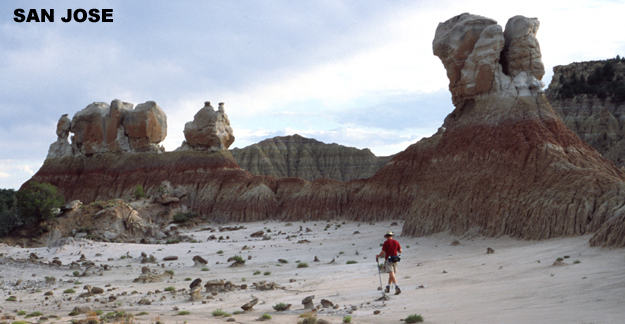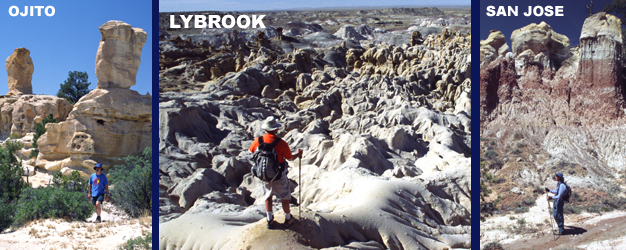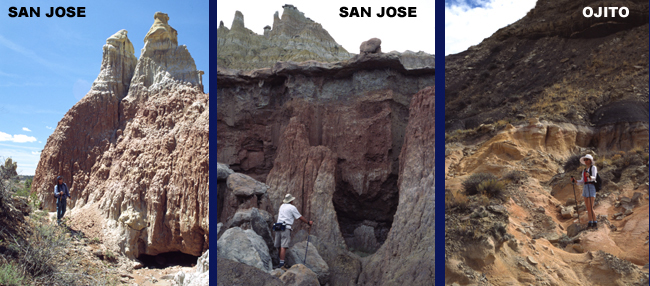
HIKING THE BADLANDS
San Juan Basin badlands offer the most unusual hiking experiences in the southwest; but the complete lack of trails, route markers, and surface water combined with isolation require extra care to avoid dangerous situations. Over many years of exploring and photographing the badlands, I have rarely encountered other hikers--even at the relatively well known Bisti Wilderness. This is both good and bad news. The good news is that you can pretty much have these giant outdoor sculpture exhibitions to yourself for a genuine high desert wilderness experience. The bad news is that if you run into trouble you’re on your own. OPTIMAL TIMES TO HIKE Weather extremes add greatly to potential problems. The 6000 – 8000 feet elevation range guarantees both seasonal and large daily temperature variation along with intense sunlight. Generally speaking the long New Mexico spring and fall are the best seasons to hike the high desert. However the many warm, sunny winter days are also quite enjoyable and snow only adds to the surreal quality. May and June afternoons can be dangerously hot and dry, but early morning hiking is extremely pleasant. The 2-3 month long monsoon season beginning in late June, with its sudden, torrential downpours, is probably the most dangerous time to drive the back roads or hike the labyrinths because of deep mud and flash floods.
RECREATION INFORMATION Very little recreation information exists on any of the badlands. The BLM publishes a few pamphlets on the Bisti, De Na Zin, and Ojito wildernesses. Some New Mexico hiking “guidebooks” mention a few of the various other badlands. The most comprehensive sources are my articles in New Mexico Magazine over the years and this web site. The two BLM recreation specialist contact persons are: Albuquerque District of the Rio Puerco Field Office: Donna Dudley – 505-761-8700 Farmington Field Office: Rich Simmons – 505-599-8900 FINDING THE BADLANDS All 9 badlands lie on either BLM or Forest Service land and are open to the public, but access can sometimes be tricky. Only a few have any road markers or map indicators. None are easy to find, although some are much further from pavement and obscure than others. See the locations map. Each individual badlands page has directions. Rough dirt roads into the hiking start points vary from a few to over 30 miles. A “high clearance” vehicle is recommended for all approaches, and four wheel drive for some. Getting confused and temporarily lost in the New Mexico outback road network or becoming seriously stuck in mud after bad weather present real risks. Any significant precipitation can turn the San Juan Basin back roads into impassable quagmires. Never drive beyond established roads. Always know when to turn the engine off and start walking. Besides getting stuck, vehicles can damage delicate formations and cause erosion.
FOOT TRAVEL No trails or markers through the rugged, confusing terrain, necessitates route finding, frequent backtracking, scrambling, some climbing, and carrying ample water. All those strange hoo doos and maze-like dry wash networks can start looking alike after awhile. Pause frequently when hiking in, turn around to the direction you will be returning, and mentally catalog obvious landmarks for the trip back out. Getting lost or injured can mean dehydration, heat stress, or hyperthermia for the unprepared. Although the distances are not always exceptionally far, cross country travel over rough, unpredictable terrain can be tiring, especially for those inexperienced in this type of hiking. Check the weather forecast before planning a trip and keep an eye on the sky in case the conditions change. Walking through ankle deep mud is worse than trying to drive it. Always use extra caution, especially during or after precipitation, when entering steep, narrow washes, cavities or overhanging earth grottos. Flash floods, cave ins, mud slides, or falling through thin crust into underground chambers or sink holes present real dangers.
If you enjoy climbing cliffs, rock slides, or canyon walls, then opportunities abound. But again the isolation makes any potential injuries more critical. Always carry lots of water, and depending on the season warm, waterproof clothes or sun protection. PROTECTING THE BADLANDS Protecting and respecting the surprisingly fragile badlands environments can be summed up with the well known wilderness hiking ethic: “Take only pictures and leave only footprints.” Careless route finding can damage delicate hoo doo formations, rare plant or wildlife species, struggling desert vegetation, or even ancient kivas and pueblos. Collecting fossils, petrified wood, or archaeological artifacts like arrow heads and pottery shards is unethical and in most cases a federal law violation. Needless to say defacing petroglyphs or ancient rock structures brings heaps of bad karma. Leaving garbage and unburied fire pits are also absolute no-no’s. So far there have been very little problems from ORV vehicles, but in some cases the potential exists. OVERNIGHT CAMPING Backpacking or car camping at the badlands is enjoyable, although not particularly convenient, due to no water, facilities, and sometimes campfire fuel. Established camping areas don't exist, but unlimited wide open spaces abound. Wind protection and shade are also in rare supply. Basically you bring everything you need with you. Dig small pit toilets and use sunken fire pits, if you must burn wood, both of which can be filled in later. Pack all garbage out. One advantage to overnight camping is hiking during early morning, or evening hours. Photographers call these times the “magic hours” or “sweet light.” Oblique sun angles accentuate intricate forms, textures and three-dimensional depth while softer light emphasizes the more subtle colors.
|
| HOME |
GEOLOGY |
PHOTOGRAPHY TIPS | RECREATION | MAP - INDIVIDUAL BADLANDS |
| INDIVIDUAL BADLANDS PAGE | PHOTO TOURS |
BADLANDS OVERVIEW |
This site is property of PhotoTrekNM. All rights reserved. Copyright 2007.




